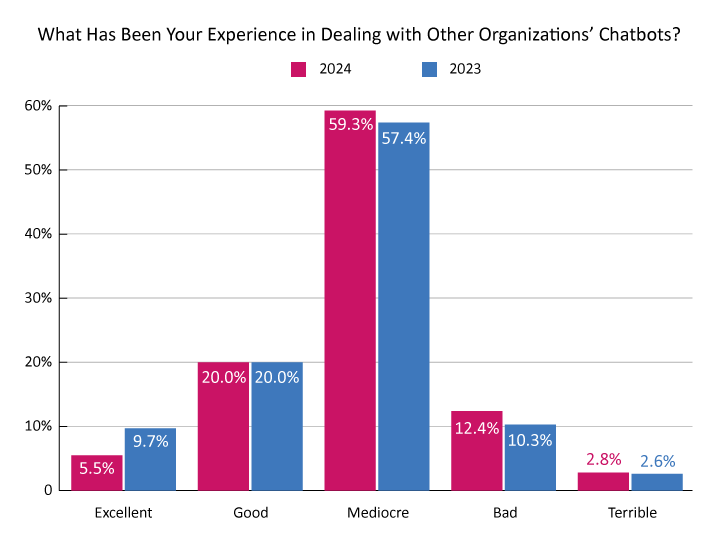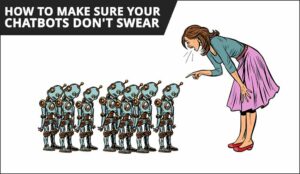If you skim the headlines, you’d be forgiven for thinking everyone hates chatbots and they have no place in a successful CX strategy. Even our own Call Centre Helper report highlighted that personal experiences with chatbots vary drastically – from excellent to the downright terrible…
Yet adoption rates are climbing, with the same report showing that 42% of contact centres have a chatbot in place, and a further 32% have it on their wish list.
So, what’s really happening here? Are chatbots just the tech we all love to hate?
We asked the experts to find out….
There Are Lots of Compelling Reasons Why Chatbot Adoption Is on the Rise…
“Chatbots Are Available 24/7, Giving Customers Access to Instant Support Anytime”
Chatbots’ 24/7 availability ensures that customers receive instant support any time, improving overall satisfaction and reducing wait times. Many customers now expect to start with a chatbot before speaking with a live agent, especially for simple questions or quick updates.
Recent advances in AI and natural language processing have also made chatbots more effective and user-friendly, leading to more natural, intuitive interactions.
As organizations look to enhance customer experience while optimizing resources, chatbots are becoming a key part of the modern contact centre toolkit – despite occasional negative perceptions.
Contributed by: Jonathan “Kenu” Escobedo, Customer Success Manager, Miarec
“Younger Generations Don’t See Chatbots as Annoying, They See Them as the Default”
We’re seeing a real behavioural shift happening alongside the technology shift. Younger generations don’t see chatbots as annoying, they see them as the default.
Messaging-first interactions are their comfort zone. They don’t want to sit on hold or wait for a follow-up email. They want instant, self-service support. When a chatbot delivers on that, it’s not hated, it’s appreciated.
Contributed by: Jonathan Mckenzie, Senior Manager and AI/Chatbot Expert, 8×8
“Chatbots Have Massively Improved Since the Days of Basic Menu-Based Interactivity”

The drivers for today’s increased chatbot adoption are twofold: the continual rise in the cost per agent-answered call, coupled with overall improvements in chat technology.
As agent salaries increase, so do call costs, and contact centre leaders are anxious to improve their bottom line by deflecting as much call volume as possible to self-service.
Meanwhile, customer resistance to chatbots has diminished in the face of the more sophisticated technology we’re seeing.
In the last few years chatbots have gone from basic menu-based interactivity to natural flowing conversations that help customers feel more as if they are speaking with a real agent. There has also been a rise in the complexity of tasks that chatbots can complete.
Pair the improved performance with the increased cost of labour and it makes sense why so many are revisiting the tech that they may have avoided in the past.
Contributed by: Shaun McCurdy , Virtual Agent Product Manager, Enghouse Interactive
“They Play a Vital Role in Accessibility and Multilingual Support”

Today’s contact centres are under pressure to do more with less: serve more customers, offer 24/7 support, and maintain quality, all while managing cost and agent engagement. Chatbots, when implemented well, help achieve that.
They’re scalable, consistent, and can resolve simple queries instantly, freeing up agents for more complex, emotionally nuanced tasks. They also play a vital role in accessibility and multilingual support, helping brands connect with more diverse customer bases.
Contributed by: Tara Aldridge, Strategic Services Director, Vonage
Yet There’s Still Progress to Be Made to Perfect the Overall Customer Experience…
“You Cannot Just Plug a Chatbot Into Your Customer Service Channel and Expect It to Work Perfectly”

We have, thankfully, got to the stage now where most organizations understand that you cannot just plug a chatbot into your customer service channel and expect it to work perfectly – everyone knows that AI technology needs training before it is implemented.
Yet, many contact centres are failing to monitor the success of their bots and continue to train and coach them once they are live.
The good news here is that by tracking bot automation and experience scores, contact centre managers can quickly and easily gain insight into where chatbots are performing well and where they are causing customer frustrations.
Monitoring these key KPIs, along with the cost per automated conversation, allows contact centres to increase automation and improve customer experiences, whilst driving down costs.
Contributed by: Magnus Geverts, VP Product Marketing, Calabrio
“The Strategy Needs to Be Channel Shift – Not Channel Shove!”

Beware just prioritizing cost-cutting! Avoid stumbling into scenarios like Channel Shove – forcing customers to digital channels to save money, over Channel Shift, where chatbot automation can genuinely deliver rich experiences AND enhance CX.
Whether chatbots succeed or fail is largely down to whether they handle the tasks customers actually need. ‘Brittle’, rule-based workflows that fail to adapt – or worse, don’t seamlessly escalate to your agents – lead to frustration and double handling, which is bad for everyone.
Bots should be reducing overall volumes while maintaining (or better still improving) CSAT. Too often, chatbots also remain static post-launch, which reduces success. Continuous refinement is key, using data insights to continually optimize digital CX
Contributed by: Lewis Gallagher, Senior Solutions Consultant, Netcall
“Chatbots Need Access to Organizational Knowledge Bases and Customer History to Succeed”

One of the biggest chatbot frustrations stems from lack of integration.
Many chatbots operate in isolation, with limited access to organizational knowledge bases or customer history. Without proper integration, they provide generic, unhelpful responses.
So ensure chatbots have access to company-wide knowledge and customer data for richer, more contextual interactions.
Chatbots should not be viewed as a set-and-forget tool or a standalone component. The key to success is a connected strategy and continuous refinement.
Contributed by: Nicolas Marcoin, Principal Product Marketeer, Odigo
“A One-Size-Fits-All Approach Just Doesn’t Work”

The most common mistake businesses make when implementing AI agents is assuming a one-size-fits-all approach.
AI agents trained on generic data often fail to meet industry-specific needs, leading to poor customer experiences. To avoid this, businesses should select AI agents purpose-built for CX, which includes being trained on customer service and organization-specific data to provide accurate, relevant responses.
This will result in fast, accurate, and personalized support, leading to higher customer satisfaction and loyalty – and industries like healthcare will benefit hugely from AI agents and intelligent virtual assistants as they can address routine patient needs at scale.
Contributed by: Elizabeth Tobey, Vice President of Marketing, NICE
Our Survey Report: What Contact Centres Are Doing Right Now cleared showed that chatbot experiences were in need of improvement:

“Many Contact Centres Still Don’t Allow Customers to “Escape From Chatbot Jail”
Many contact centres still don’t allow customers to “escape from chatbot jail”, or if they do, the handover is poor, forcing customers to repeat themselves.
Any customer service chatbot interaction should have a robust escalation process or alternative channels in place to allow customers to connect with a human at any time. The chatbot may have exhausted its capabilities, or perhaps a customer just doesn’t like chatbots.
Contributed by: Shaun McCurdy , Virtual Agent Product Manager, Enghouse Interactive
“Some Chatbot Responses May Still Come Across as Robotic or Unhelpful”

Despite their growing capabilities, chatbots still have limitations. They often struggle to understand complex questions, emotional nuance, or context, which can lead to frustrating customer experiences.
Without the ability to detect tone or sentiment, some chatbot responses may come across as robotic or unhelpful.
To avoid these pitfalls, contact centres should take a proactive approach. Regularly updating chatbots with insights from real customer conversations can significantly improve their accuracy and relevance.
Contributed by: Jonathan “Kenu” Escobedo, Customer Success Manager, Miarec
“Leaders Need to Invite More Diverse Voices Into Testing to Uncover Bias and Blind Spots”
The chatbot backlash isn’t without cause. Many experiences still feel clunky, impersonal, and frustrating. Most chatbot failures come down to poor design, limited integration, and a lack of empathy.
When bots can’t understand context, escalate appropriately, or speak in a way that reflects brand tone and accessibility needs, customers rightly get annoyed.
Including diverse voices in testing to uncover bias and blind spots can help. The most successful chatbot strategies treat them as part of a broader experience ecosystem – not a standalone tool.
When done right, they don’t just deflect calls – they enhance CX, reduce agent load, and make customers feel supported, not sidelined.
Contributed by: Tara Aldridge, Strategic Services Director, Vonage
“Agentic AI Is Now Unlocking Capabilities We Couldn’t Have Imagined Just a Few Years Ago”

Chatbots aren’t the enemy! In fact, they’re becoming one of the most effective ways to scale great customer service. And with agentic AI, we’re now unlocking capabilities we couldn’t have imagined just a few years ago, from resolving complex billing issues to coordinating logistics in real time.
Agentic AI promises a better future, moving beyond simple question-and-answer logic and making decisions, adapting on the fly, and performing complex tasks across multiple systems all while keeping the user experience natural and fluid. It’s not just reactive; it’s proactive, but it still needs data and training.
Contributed by: Jonathan Mckenzie, Senior Manager and AI/Chatbot Expert, 8×8
We’re Experiencing Very Similar Challenges With Chatbots to What We Historically Saw With the Evolution of IVRs

All customers want is to have their problem solved, and if it’s done efficiently and effectively, and the chatbot works, then brilliant!
It’s when it becomes a barrier that chatbots become a problem – especially when customers get stuck in a doom spiral, unable to find a way out and speak to a human advisor.
While we’ve still got some way to go here, these problems are all very similar to what we experienced in the early days of IVR, which have come a long way – so there’s lessons to be learned all round here, but chatbots are definitely here to stay.
Contributed by: Nicola Millard, Principal Innovation Partner at BT Group
Are Chatbots the Tech We All Love to Hate?
Join our LinkedIn community and let us know.
For more great insights and advice from our panel of experts, read these articles next:
- 10 Game-Changing Ways Emotion Will Shape the Future of CX
- New Ways to Empower Agents in 2025
- From Chaos to Control! Why Contact Centres Are Prioritizing WFM Solutions
- Can AI Really Handle Customer Complaints?
Author: Megan Jones
Reviewed by: Jo Robinson
Published On: 29th Apr 2025
Read more about - Technology, 8x8, Artificial Intelligence (AI), Calabrio, Chatbots, Customer Experience (CX), Elizabeth Tobey, Enghouse Interactive, Jonathan Kenu Escobedo, Jonathan Mckenzie, Lewis Gallagher, Magnus Geverts, MiaRec, Netcall, NiCE, NiCE CXone, Nicola Millard, Nicolas Marcoin, Odigo, Shaun McCurdy, Tara Aldridge, Top Story, Vonage











































